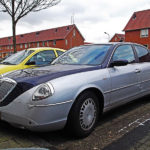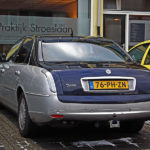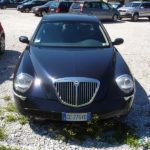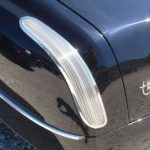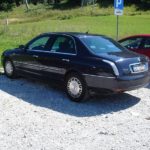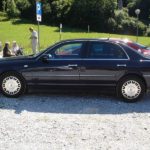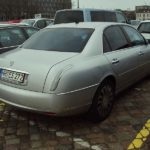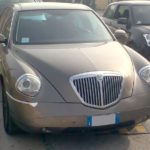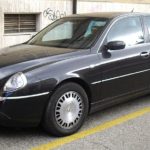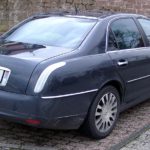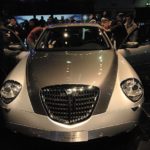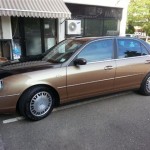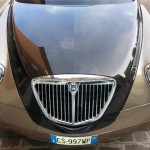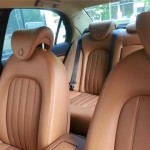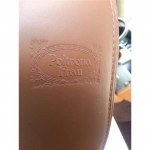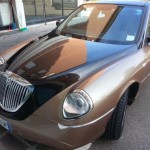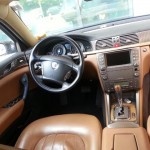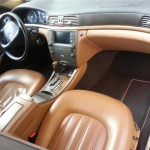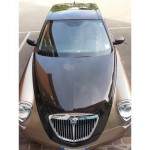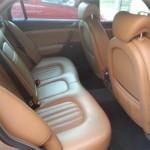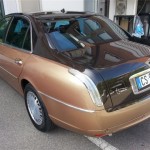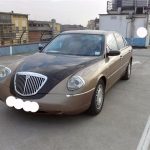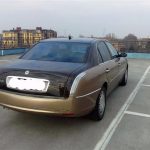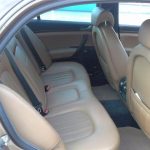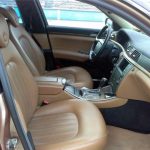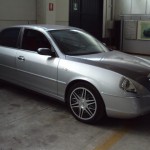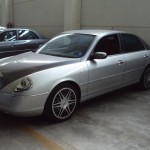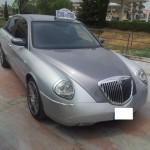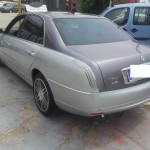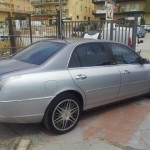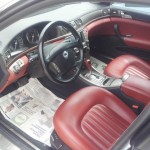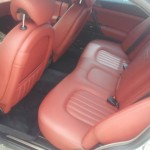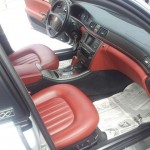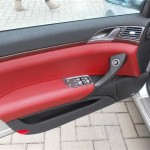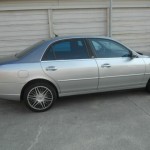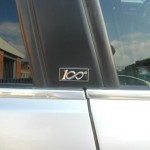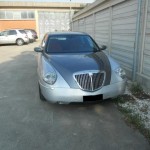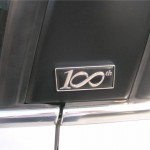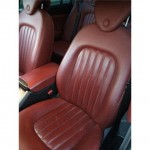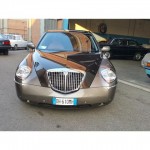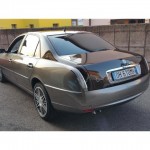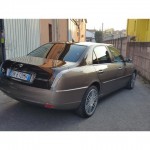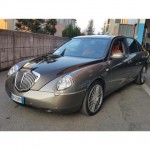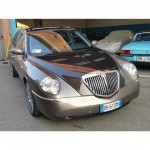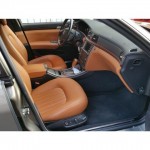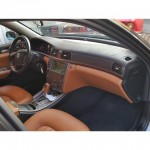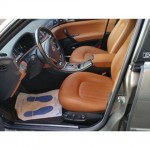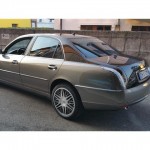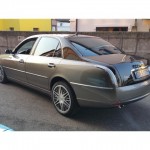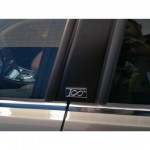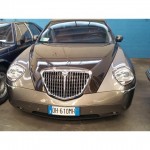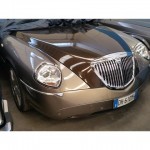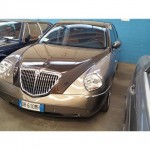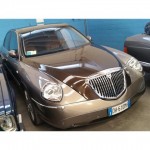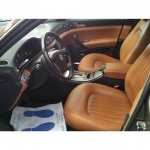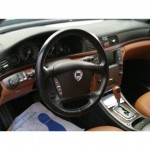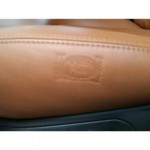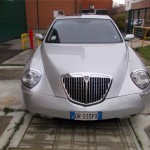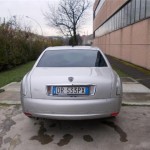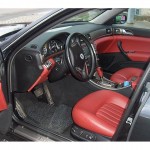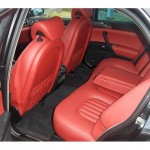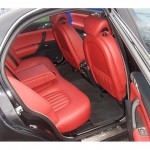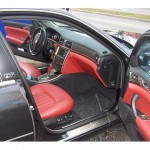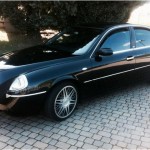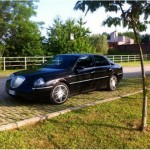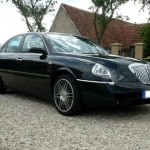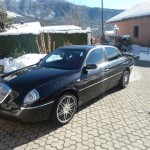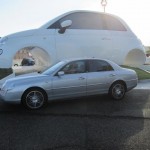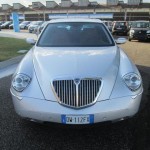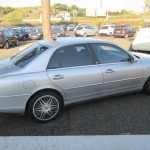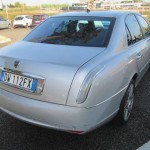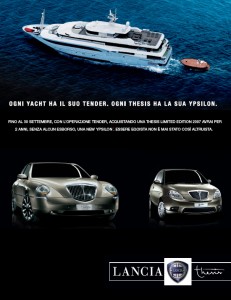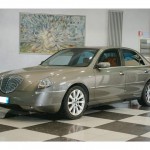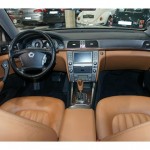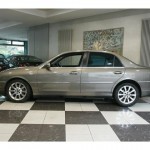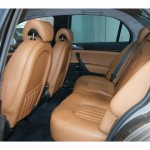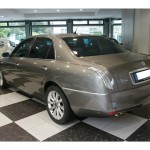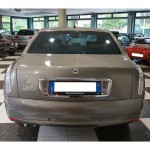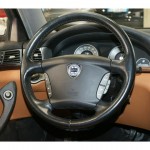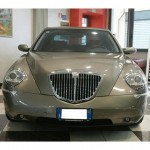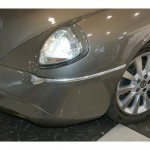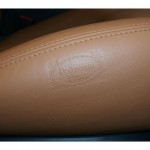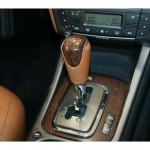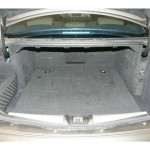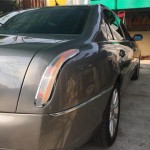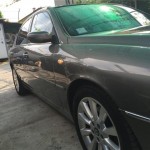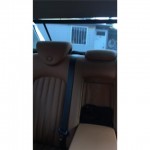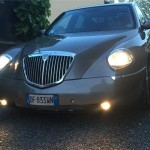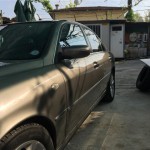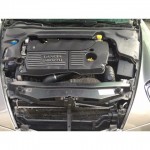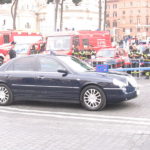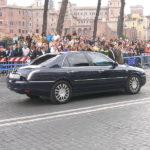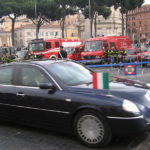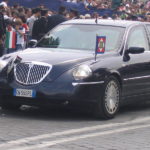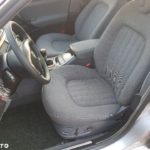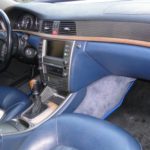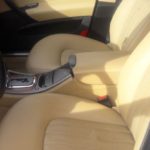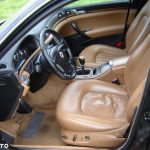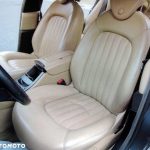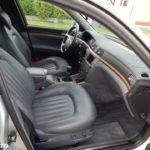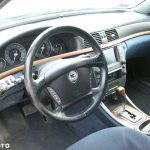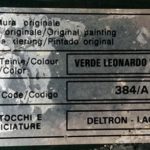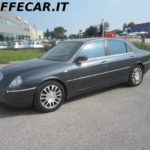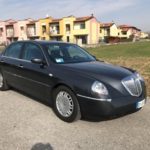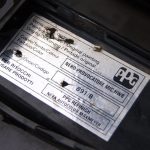2001-2009 Lancia Thesis
Designed by: Michael Vernon Robinson at Centro Stile Lancia. Interior design Flavio Manzoni.
Tipo 841
Number made: 16,718 approx.
First VIN
ZLA84100000000997
Vehicle: 00000015
Prod. date: 20/2/2001
Last VIN
ZLA84100000018789
Vehicle: 00016718
Prod. date: 10/3/2009
Concepts and prototypes:
1996 Tikal by Andrea Bassi, Arca by Pietro Camardella, Agorà by Marco Tencone.
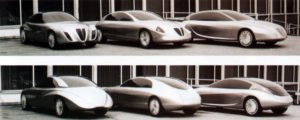
1998 Lancia Dialogos by Pietro Camardella and Marco Tencone at Centro Stile Lancia under Michael Vernon Robinson. Interior design Flavio Manzoni.
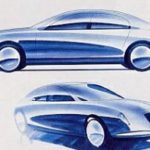
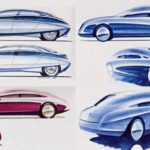
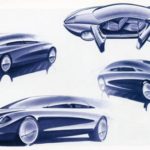
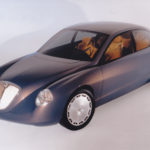
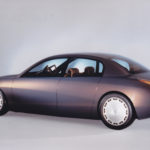
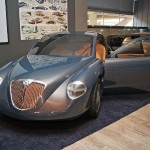
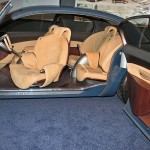
2000 Lancia Giubileo by Michael Vernon Robinson at Centro Stile Lancia.
One-off laundalet presented to Pope John Paul II.
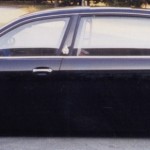
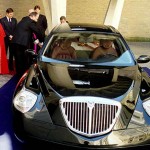
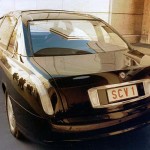
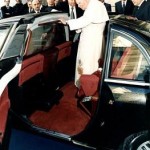

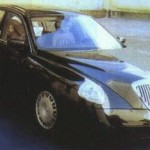
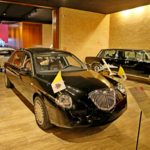
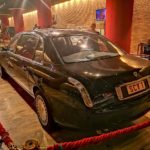
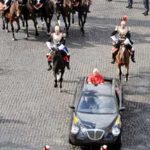
2004 Lancia Thesis Stola S85 by Stola SpA
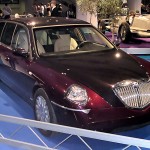
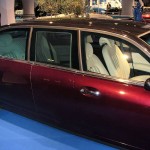
https://www.collectorcarads.com/Lancia-Stola-S85/59164
“only 3 cars built” (One for Pope was the Giubileo not Stola)
2003 Lancia Thesis Promenade. Prototype with 3,2 V6.
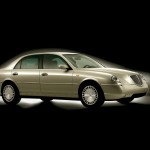
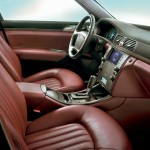
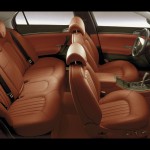
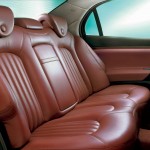
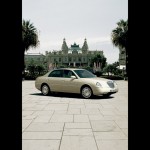
Limited Editions:
‘Bicolore’ or ‘Unique’ 2004.
Thesis ‘Bicolore’ for sale on Autoscout24
Centenario Elegante ‘Premier’ (2006-2007)
For 2006 and 2007 Venice Film Festival. 20-40 made.
115.599.0.0 – 2.4 JTD 20V 175CV 129KW E4 CAE S.S. CENTENARIO ELEGANTE
401 Rosso Vienna
Black centre console tunnel sides and carpets
4J1 ‘bicolore’ option code (Grigio Palladio and Grigio Alfieri)
flagpoles on front mudguards
https://www.thesisclub.it/?page_id=67
Centenario Elegante, 100th anniversary (2006).
Silver-grey two tone, red leather or Rossini grey-brown two tone, Cuoio Havana leather
115.599.0.0 – 2.4 JTD 20V 175CV 129KW E4 CAE S.S. CENTENARIO ELEGANTE
401 Rosso Vienna
4J1 ‘bicolore’ option code (Grigio Palladio and Grigio Alfieri)
Black centre console tunnel sides and carpets
Thesis Centenario Sportiva for sale on Autoscout24
Centenario Sportiva, 100th anniversary (2006).
Black or Silver, red leather.
115.499.0.0 – 2.4 JTD 20V 175CV 129KW E4 CAE S.S. CENTENARIO SPORTIVA
401 Rosso Vienna
Grigio Palladio or Nero Donatello
Black centre console tunnel sides and carpets
S.T. Dupont, french market (2007).
115.599.0.0 – 2.4 JTD 20V 175CV 129KW E4 CAE S.S. CENTENARIO ELEGANTE
690A Grigio Rossini Met.
495 Cuoio Havana Poltrona Frau
Black centre console tunnel sides and carpets
Limited Edition 2007
115.599.0.0 – 2.4 JTD 20V 175CV 129KW E4 CAE S.S. CENTENARIO ELEGANTE
690A Grigio Rossini Met.
495 Cuoio Havana Poltrona Frau
Black centre console tunnel sides and carpets
Versions:
Versions
115.265.0.0 – 2.4 JTD 10V C.M. 6M ALLESTIMENTO AZIENDE
115.363.0.0 – 2.4 JTD 5C 20V 175CV 120KW C.M. F40 EXECUTIVE
115.363.0.1 – 2.4 JTD 5C 20V 163CV 129KW C.M. F40 EX-DEPOTENZIATO
115.364.0.0 – 2.4 BZ. 5C 20V C.M. LS
115.365.0.0 – 2.4 JTD 10V C.M. 6M LS
115.368.0.0 – 2.0 TB.BZ. SOFT 6M LS
115.372.0.0 – 3.2 BZ. V6 24V CAE CF4 LS
115.373.0.0 – 2.4 JTD 20V 175CV 120KW CAE EXECUTIVE
115.373.0.1 – 2.4 JTD 20V 163CV 120KW CAE EXECUTIVE-DEPOTENZIATO
115.374.0.0 – 2.4 BZ 20V C.A. AISIN LS E3 170CV
115.376.0.0 – 3.0 BZ. V6 24V CAE LS
115.379.0.0 – 2.4 JTD 20V 175CV 129KW E4 CAE EXECUTIVE
115.463.0.0 – 2.4 JTD 5C 20V 175CV 120KW C.M. F40 EMBLEMA
115.463.0.1 – 2.4JTD 5C 20V 163CV 120KW C.M. F40 EMBLEMA-DEPOTENZIATO
115.464.0.0 – 2.4 BZ. 5C 20V C.M. LX
115.465.0.0 – 2.4 JTD 10V C.M. 6M LX
115.468.0.0 – 2.0 TB.BZ. SOFT 6M LX
115.472.0.0 – 3.2 BZ V6 24V CAE. CF4 LX
115.473.0.0 – 2.4 JTD 20V 175CV 120KW CAE EMBLEMA
115.473.0.1 – 2.4 JTD 20V 163CV 120KW CAE EMBLEMA-DEPOTENZIATO
115.474.0.0 – 2.4 BZ 20V CA. AISIN LX E3 170CV
115.476.0.0 – 3.0 BZ. V6 24V CAE LX
115.479.0.0 – 2.4 JTD 20V 175CV 129KW E4 CAE EMBLEMA
115.499.0.0 – 2.4 JTD 20V 175CV 129KW E4 CAE S.S. CENTENARIO SPORTIVA
115.599.0.0 – 2.4 JTD 20V 175CV 129KW E4 CAE S.S. CENTENARIO ELEGANTE
115.772.0.0 – 3.2 BZ. V6 24V CAE CF4 BLINDATA B4K – 5POSTI
115.872.0.0 – 3.2 BZ V6 24V CAE CF4 BLINDATA B4-5POSTI
115.876.0.0 – 3.0 BZ. V6 24V CAE BLINDATA B4
115.972.0.0 – 3.2 BZ V6 24V CAE CF4 BLINDATA B6-5POSTI
115.976.0.0 – 3.0 BZ. V6 24V CAE BLINDATA B6
Interior codes:
Exterior colour codes:
Press releases
Lancia at the 67th Turin International Motor Show, 20 April 1998
https://www.lanciapress.com/press/article/2927
Dialogos: see and touch the future
Lancia shows us the future of élite motoring at the Turin Motor Show. An imminent future, destined to take shape on the next models produced by the brand. Lancia has decided to show us the future instead of tell us about it: all the innovations can be seen and touched on the stand. They are all packed into a concept car, which has been named the Lancia Dialogos.
The name describes a car able to receive signals and decode them. To adapt to changing user characteristics and requirements, to set up a new, different dialogue and relationship between man and machine. This is the philosophy behind the ‘biodynamic car’. Its aim is to update Lancia’s original mission – to build prestigious, distinguished, comfortable cars – for the new millennium.
Not merely a vehicle to be driven, but a place to live. A space where material is used to ensure wellbeing and good looks. A passenger compartment conceived as an ideal microclimate and living room where one is free to enjoy stress-free driving.
Dialogos is the result of taking Lancia’s extraordinary heritage to the next logical stage. To explore future worlds, where technology makes every dream come true. We chose to limit ourselves to solutions which will really be applied to standard production cars: solutions that meet new yet stringent design criteria.
The car admired by visitors to the Lancia stand is a paradox: it takes its inspiration from tradition yet points to the future. The result is a big, five-metre long deluxe car with retro hints: high front, long bonnet, upturned wedge-shaped profile. These hints are immediately denied by an interplay of smooth curves and rounded edges, that speaks a completely new and appealing stylistic language.
The Dialogos immediately opens its doors to passengers approaching with their personal Ego Cards in hand. The doors open book-fashion as on the Aurelia and Appia; the technology required to design a car without a central pillar but still able to pass today’s severe crash tests can only be imagined. Through the doors lies a roomy, comfortable and relaxing lounge. After all, the ideal of every journey is to feel at home, surrounded by an environment we like, among things arranged the way we want them.
So the front seats turn outward through 90° to allow the driver and passenger to sit down, before returning to their original position. The car recognises people by means of their Ego Card personal keys and adapts to their habits, life styles and driving styles: left hand drive or right hand drive, steering wheel and pedal unit, climate control, light distribution and intensity – and sound. Conventional seats have been replaced by armchairs. These mould themselves around the body. Ventilation and lighting of the preferred colour and intensity are diffused through breathable trim. As we wallow in an environment of wrap-around, continuous forms, our senses are soothed by wood that is soft to the touch, chamois leather, cashmere and relaxing images from three screens on a facia. Yet the facia is not in the normal place, but tucked away at the bottom where it cannot get in the way.
Now all we have to do is insert our Ego Card in its slot and press to start the car. The car interior lights up by itself (a little touch of magic). Information on the screens and the cruise control is controlled by a joystick similar to a TV remote control. The car also reacts dynamically according to the preferences of the driver: suspension setting, drive torque distribution over both axles, degree of oversteer etc. An anticollision radar is in operation and hidden TV cameras ensure a perfect 180° rear view with no blind spots. The headlamps automatically adapt light beam intensity to external conditions.
When the car stops, the front seats can be turned through 180° so that the passengers can chat or work face to face. Screens and keyboards, minibar, table and document holders can appear at will from the clean, uncluttered lines of the interior.
All this and more make up the Dialogos. Before we go on, it is worth considering the principles that inspired the designers responsible for Lancia’s concept car.
A new relationship with the car
This élite car for the third millennium will overturn a commonly held misconception: that wealth means owning flashy, costly items. In today’s society (and this will be even more true in tomorrow’s world), true luxury means no obstacles to the satisfaction of one’s desires and needs. This means doors swinging open at our approach and nothing standing in the way of our communication with technology. Be it navigator, radio, climate control system or screen, we should not have to adapt to the way it works. Instead the instrument interface should adapt to us.
This also means being able to live in an environment attuned to our current mood, that allows us to experience a new type of comfort. Wellbeing based on sensory oneness, perceived in an environment where objects have not been designed for appearance alone, but also for the way they feel, sound, smell and – naturally – the way they look.
The Lancia designers undertook the far from easy task of designing something intangible: i.e. the quality of the relationship between man and car, the sensation of motoring and the aesthetics of sound, smell and touch. This new soft revolution is not based on hard technology as in the past (a case in point was the 1922 Lambda with its impressive total of seven world patents) but still radically changes our experience of the car.
The result is the Dialogos, a car capable of discreetly serving its user and re-interpreting age-old Lancia precepts for a new age: dynamic design, advanced technology, the quest for absolutely élite comfort and sophisticated solutions.
The thing that counts on Lancia’s concept car is the new relationship offered by a ‘biodynamic car’. The opportunity to live in an environment that is simultaneously ideal microclimate and living room while also offering a stress-free drive. The body that the Lancia Style Centre has dreamed up for this paragon contains frequent references to the past and pointers to the future. It embodies the concept of an evolving tradition.
A timeless sculpture
The external styling of the Dialogos speaks for itself. It is patently the result of a profound rethinking of Lancia traditions to cater for the future tastes and needs of the most sophisticated and demanding customers.
The mighty yet fluid and stylish front end draws inspiration from classic themes. As on the Lambda, its flat straight grille is a true radiator. The styling rejects the idea of a wedge attacking the asphalt in favour of an upturned wedge shape. The front box, with its long high bonnet, draws the rest of the car behind it and the passenger compartment is shifted backward with the boot almost an appendage.
The body lines are long: soft lines swoop and turn without apparent effort. The shape is square, but this is no soap-dish. A careful use of rounded edges mixed with smoother sections produces a stylistic language that is unusual, but also well-proportioned and continuous.
Shield-shaped rims (19″) and tyres with a specially-designed tread ensure style and practicality. Adaptive headlamps lit indirectly from a concealed source look like diamonds. They seem so clear and bright, then suddenly break down into a myriad of facets. This magical lighting system is repeated by the rear neon lights.
All exterior elements that could make the car look too visually busy (handles, door mirrors, wipers and aerials) have disappeared. The Dialogos looks for all the world like a sculpture. This impression is accentuated by the fact that divisions between panels have been minimised and the central pillar is apparently missing. The colour of the windows (there is apparently only one) is very similar to the incredible blue of the body.
Yet this impenetrable object suddenly opens out into a roomy lounge with linear, simple lines, based on classic international furnishing standards. The front armchairs are supported by a sturdy central mount but look as though they are hanging in the air. Their head-restraints and armrests look like cushions thrown artfully onto a sofa at home. The extended, continuous interior surfaces disseminate air, light and sound. Compartments and spaces are present, but hidden, waiting to open when needed.
Your trip into the conveniences of the third millennium begins here. Lancia’s concept car is designed in accordance with three main guiding principles: the car as ideal microclimate, the car as living room and stress-free driving.
Life in an ideal microclimate
Imagine an ideal microclimate where all climatic, acoustic, visual and even olfactory conditions transmit pleasant, protective, healthy and relaxing sensations. This is the Dialogos’s passenger compartment. Air quality and distribution, lighting, protection and ergonomic comfort are all finely tuned to produce non-aggressive, silent climate control.
These results have been achieved by doing away with all intrusive or bulky items and the Top Climate System has been created. This system considers all aspects of the on-board climate. It controls the temperature of all breathable interior walls and also cleanses and deodorises the air by means of regenerable active carbon filters.
Air does not circulate in this system. Instead, an atmosphere diffuses through extensive breathable surfaces such as the walls and roof panel. Air is finely distributed through micropores in the trim materials to keep passenger compartment temperature constant. Because there are no outlets, fan speed and noise is reduced for an overall increase in efficiency.
The system also allows passengers to adjust heating to their own requirements. Four customised microclimates are created by measuring perceived heat by means of detectors fitted in the seats. The system also measures external temperature, humidity and pollution conditions. Once all data have been processed, ideal conditions can be created.
Passengers use their own joysticks to adjust their microclimates to individual taste. The on-board computer stores the data, which may then be called up quickly when required.
In a word, the Top Climate System can pick up on the current mood and use its many sensors to envelop each passenger in a beneficial, healthy cocoon at just the right temperature. These conditions can be customised and memorised.
The diffuse lighting inside the ideal microclimate is made up of different shades. All of these are warm and designed to reflect a home-like atmosphere. They offer the colour and brightness best suited to different situations and occasions.
The materials and components inside the passenger compartment have been chosen to meet the needs of superior quality of life on board. They are good to look at and good to touch. The seats are trimmed with nabuk, a soft, fluffed leather similar to chamois. The roof is trimmed with a wool blend cloth and silk. The facia, squab backs and flaps are in soft wood. This material consists of a film of real wood bonded to a layer of resin and foam. It is soft to the touch, deformable (it bends when the doors are opened and yields to the pressure of a finger) and combines attributes of safety with a sensation of naturalness and warmth.
A living room with wheels
The environment on board the ‘biodynamic car’ is spacious, comfortable and relaxing. Every part is made out of top-quality material and chosen with care to express sophisticated unfussy taste. The space is flexible because it can be converted at will into a passenger compartment where one can travel in the greatest imaginable comfort, a lounge for conversation, a place of entertainment with the option of listening to good music or watching a video, or even a place for study and work.
To get into Lancia’s concept car, simply approach with your Ego Card. This personal key automatically manages various functions and also stores the characteristics of its user. The front doors open, the car is raised or lowered to suit the driver’s height and the seat swivels outward to allow you to get in. Once sitting down, the seat moves back in and round into the driving position. The doors now close automatically.
The front armchairs can carry out 12 different movements (automatically controlled) and form a single sofa when placed together, which configures itself to suit the form and sitting position of its occupants. The configuration is stored for subsequent use but may be changed – to suit a new passenger, for example. The seat squab back is covered in soft wood and the edge is finished in heartwood. The head-restraints and armrests are made out of constant thickness cushions. The whole front bench may be turned through 180°. This action converts the passenger compartment into a comfortable lounge, ideal for a tête à tête conversation with back seat passengers.
A display with a double 14-inch screen can be removed from a service compartment in the middle of the back seat. The back seat is also fitted with a socket for a personal mobile phone, while the head-restraint is fitted with headphones for listening to music. Simply lean back to listen to the sound. Back seat passengers can also remove an infra-red keypad from a housing in the door in order to interact with the on-board computer.
The door panels are also sophisticated and refined. Nabuk is abundantly in evidence and the oddments compartments are made out of deformable material covered in soft wood. The light, air and sound dissemination areas are covered in clear, breathable metal cloth. The bar compartment is located on the left rear panel. It is closed by a flap – unhinged, because this too is made out of soft, deformable wood. A small table is available in the area at the rear on the left.
Luxury, yes, but without ostentation. Innovation, certainly, but with precise references to timeless values. Flexibility to the widest range of needs and great functionality. Ultimately the most gratifying way of experiencing life on board a car.
Stress-free driving: a dream come true
A car designed for stress-free driving must be able to anticipate motorists’ needs. It must be able to adapt to their habits and – why not – to their mood and also to current situations. Lancia opted for a high level of automation to fulfil these functions. The car features a man-machine interface system, a sort of on-board assistant that sees to everything. With the gearbox, handbrake and stalk unit done away with, car use is simplified to the greatest degree. This is also helped by the use of vocal commands. The system provides useful information to the driver and puts the driver at ease by customising certain functions. The system ensures a high degree of safety. Both driver and passenger enjoy full control of the car for complete physical and mental wellbeing.
In practice, this means that the steering column is located in the middle when at rest to allow the driver to get into the car. Because it is hinged at the base, it can be driven equally well on the left or on the right. The instrument panel moves to accommodate the change and can be reconfigured.
The steering wheel is fitted with a set of buttons to control turn signals, hazard warning flashers, horn, semi-automatic transmission functions and the voice function, which activates vocal commands.
A big panel made up of three 13.8 inch liquid crystal displays and two cards with gauges and warning lights is located in place of the facia and the conventional instruments and controls beneath the windscreen. Side display functions are reversible, according to whether the car is being driven from the left or right. The driver’s screen is reserved for the instruments and controls, while the passenger’s screen is devoted to navigation, seat and climate control system controls, radio, hands-free phone and check functions. The central monitor is used for seeing behind the car to eliminate blind spots.
The screen is controlled by a joystick with two buttons for scrolling through the main options and a confirmation key for moving within individual menus and activating the required function. The joystick is located between the front seats and is the main control terminal for on-board instruments and controls. Displays may be customised. The driver can select the language, graphics (analogue or digital), background colour, character size and is able to zoom in on a particular function.
An on-board computer system with micro-TV camera and radar provides all information required for comprehensive monitoring of the road. The system explores the field of view inaccessible to the human eye and notifies the driver of overtaking vehicles.
A TV camera ensures the car stays in lane. When the driver crosses the lane dividers unintentionally (e.g. due to loss of concentration or drowsiness), the steering wheel rim vibrates and an acoustic signal goes off as a warning.
The adaptive cruise control system controls cruising speed and the safety distance from cars in front. In poor visibility conditions (fog, rain or snow), the anticollision radar is extremely useful. This warns of potentially dangerous obstacles in the car’s path that cannot be perceived by the human eye.
To improve safety while driving at night, the Dialogos is fitted with self-adaptive headlamps. These owe their name to the fact that the beam changes direction, intensity, divergence and light distribution pattern according to car speed, type of road, the position of other cars (oncoming cars and cars in front) and atmospheric conditions. (fog, rain etc.). In the Dialogos’s headlamps, the light beam is also located beside the reflectors. This solution reduces glare experienced by other vehicles and allows effective control of the light beam.
The transmission can work automatically or semi-automatically, but the controls do not get in the way of the area between the front seats. Driving options are selected with buttons on the steering wheel and associated messages are displayed on the car monitor. The system is self-learning, i.e. it stores the motorists driving style in about five minutes. For reversing manoeuvres, the driver needs to operate a lever switch located inside the central console. The tail-lights now come on and a TV camera projects an image on the monitor in front of the driver to make parking easier.
The pedal unit may be located on the left or on the right and features only two controls: accelerator and brake. When unused, it becomes part of the floor and can be used as a footrest. The Dialogos is also fitted with rear footrests built into the back of the front seats.
No handbrake lever is present. The brake is always on when the car is at a standstill and is released automatically when the car sets off.
The mechanical components on this biodynamic concept car are also interesting. The front suspension is multilink with a virtual steering axis, while the rear suspension is also multilink. The transmission is robotised with an Ego-mode self-learning system. The active front suspension features a feeling management system – and a model reference monitoring and test system is also fitted.
The main feature of the multilink suspension is its virtual steering axis. This is mapped by virtual rather than physical suspension points. The steering axis passes through the centre of the wheel. As a result, obstacles such as potholes or uneven surfaces cannot cause the wheel to vibrate or turn.
This device ensures that steering is unaffected when the active differential applies different pulling forces to both half-axles to increase car stability. This suspension architecture also ensures high longitudinal stability and reduces vibrations from the road surface to improve car handling over all terrains.
One of the most innovative features of the multilink rear suspension is its virtual pitch centre. When riding over an obstacle, the wheel moves back to reduce interference transmitted to the body and thus perceived vibrations. An elasto-kinematic toe-in system also significantly increases car stability when cornering.
The robotised transmission is a conventional transmission fitted with an electro-hydraulic actuator. All functions normally managed by the driver (selection, engagement and release, clutch and throttle modulation) are controlled electronically. The system works automatically or semi-automatically. In the latter case, the driver changes gear by operating buttons on the steering wheel. This transmission is combined with an innovative Ego-mode system. This customises operation and adapts it to different service conditions. After a short learning period, when the driver works in semi-automatic mode, the system is able to recognise driving style and produce a customised map. This is then used automatically for different driving styles (sporty or touring) – or even on different cars equipped with the same system.
The active front differential system (which should not be confused with a self-locking differential) is designed to improve pulling power and car stability. By modulating the pressures of two clutches in the active differential, the drive torque applied to the front wheels can be controlled differentially. When entering a bend, drive torque is transferred to the outer wheel in order to exploit car traction to the full and increase lateral hold. The active differential also acts as a dynamic stabilising element to compensate for skidding in emergency situations.
The device also varies car response to controls applied to the steering wheel (typical of understeering). The differential therefore adjusts to different driving styles and driver tastes to make the car more docile – or alternatively more edgy and poised for action. As with the robotised transmission, feeling management maps are stored on the Ego Card.
The sophisticated model reference monitoring and test system forecasts car behaviour and compares it continually with true behaviour as revealed by the on-board sensors. It is therefore possible to record environmental conditions (such as gradients or grip on the road) and diagnose any anomalies (e.g. tyre deflation) or the approach of extreme road grip conditions. All this information is transferred to control systems on the car (robotised transmission, active differential), which adapt to the situation in hand to ensure greater safety and better performance. The motorist is notified of anomalies by means of a display.
LANCIA AT THE 73rd PARIS INTERNATIONAL MOTOR SHOW – 2
https://www.lanciapress.com/press/article/2927
Lancia Dialogos
According to Lancia, the future of élite driving is called the Lancia Dialogos. This concept car, exhibited alongside the standard-production models, contains many retro hints: a high front, long bonnet, reverse wedge-shaped profile. But these are immediately countered by the interplay of soft curves and rounded corners that speaks a new and appealing language.
The car’s name is a promise: to begin a new and different relationship between man and machine. The Lancia Dialogos marks the advent of a biodynamic car, i.e. a place to live and not merely a means of transport, a space where material is used to ensure wellbeing and not merely to improve appearance. Around driver and passengers is created all the practical and relaxing style of a living room but occupants also enjoy an ideal microclimate that ensures a stress-free drive.
The journey toward comfort in the third millennium begins with the passenger compartment: this constitutes an ideal microclimate where all climatic, acoustic, lighting, visible and olfactory conditions transmit pleasant, protective, healthy and relaxing sensations.
Such is the Dialogos interior.
Air cleansed and deodorised by regenerable active carbon filters does not enter the car through ventilation outlets but through broad perforated surfaces in the interior trim. This system ensures a diffuse distribution of air. Sensors in the seats measure ‘thermal sensation’ while the Top Climate System records external temperature, humidity and pollution conditions to create ideal conditions inside the car.
Every passenger is also free to control his or her own personal microclimate using a joystick. The diffuse lighting inside the ‘ideal microclimate’ features warm shades of different tonality and intensity, reminiscent of a home environment. The seats are upholstered in nabuk, a soft, smooth leather similar to suede. The roof is covered by a cashmere and silk mix cloth. The front panelling below the facia, seat squab backs and the low part of the flaps are trimmed with softwood, a film of real wood bonded to a layer of resin and foam. It is soft to the touch, deformable (e.g. it bends when the door is opened and yields to the pressure of a finger) and combines safety with sensations of naturalness and heat.
To gain access to this roomy, comfortable and relaxing living room, simply approach the Lancia Dialogos with your Ego Card in your pocket (this personal card manages various functions automatically and stores its user’s characteristics). The front door opens immediately, the car moves up or down according to the height of the motorist and the seat turns moves outward to receive the driver. Once the driver is sitting down, the seat moves back in and the door closes automatically. All that is left to do is insert the Ego Card in its slot. The car recognises the driver and adapts to his or her habits: right or left hand drive, climate control and also light and sound distribution and intensity. The armchairs that replace conventional seats mould themselves to the body shape.
The front armchairs can carry out twelve different movements (controlled automatically) and can be combined to form a single sofa that can be turned through 180º: in this way the passenger compartment can be converted to a comfortable living room, ideal for conversation. Screens and keyboards, minibars, tables and document compartments emerge from the clean, uncluttered interior as required. The rear armchairs come with a personal mobile phone socket, while the head-restraints contain earphones for listening to music. Simply tilt your head back to hear the sound. To start the car, you press the Ego Card.
The Lancia Dialogos is easy to drive. The steering wheel is equipped with a series of buttons used to control the turn signals, hazard warning lights, horn, semi-automatic gearbox function and the voice function, which activates the voice-operated controls. The facia and traditional instruments beneath the windscreen are replaced by a big panel made up of three customisable liquid crystal screens: you are able to choose the language, graphic format (analogue or digital), background colour and character size). The side screens can be configured according to whether the car is driven on the left or right. The driver’s screen is reserved for instruments and controls while the passenger screen is devoted to an extensive menu that includes ‘navigation’ and controls for the seat, climate control system, radio, hands-free phone and check functions. The central monitor acts as a rear view mirror (it displays images recorded by a TV camera concealed in the back of the car). Information is controlled by a joystick similar to a home remote control unit positioned between the front seats.
The on-board information system, complete with micro TV camera and radar, provides all the necessary information for continuous and comprehensive monitoring of the road. It explores the field of view inaccessible to the human eye and signals the presence of overtaking vehicles. It controls cruising speed and the safety distance from the car in front. If the driver crosses the lane dividers due to distraction or drowsiness, the system emits an acoustic signal to bring his attention back to the road. In poor visibility conditions (fog, rain or snow), it signals the presence of potentially dangerous obstacles in the car’s path that cannot be seen by the human eye.
To improve the safety of night driving, the Lancia Dialogos headlights adapt automatically to external conditions. Their light beam changes direction, intensity, divergence and light distribution pattern according to car speed, road type, the position of other cars and atmospheric conditions. Pedals units are fitted on the left and on the right (the same applies to the steering column hinge) and include only two controls: accelerator and brake. When unused, the unit becomes fixed and integral and acts as a footrest. No handbrake lever is fitted. The brake is always on when the car is at a standstill and is released automatically when the car is enabled for movement. The robotised Egomode gearbox with learning function can work semi-automatically or automatically. In the first case, buttons on the steering wheel are pressed to change gear and messages appear on the car monitor. After about five minutes of semi-automatic driving, the system recognises the motorist’s driving style and produces a personalised map that is stored on the ever-present Ego Card: it is used to manage gear shifts when the car is driven in automatic mode. The front suspension is multilink, with a virtual steering axis determined by virtual points instead of physical suspension points. It passes through the centre of the wheel with the result that obstacles such as potholes or rough patches do not cause the steering wheel to turn or vibrate. One of the most innovative features of the rear suspension, also multilink, is a virtual pitching centre. When the wheel drives over an obstacle, it retracts to reduce the disturbance transmitted to the body and thus the perceived vibrations. Another important feature is the elastokinematic toe-in, which increases car stability on corners.
The active front differential (which should not be confused with a self-locking differential) improves car pulling power and stability. The unit achieves this by managing the drive torque applied to the front wheels in differential manner. And more: it also acts as a dynamic car stabilising element that compensates for swerves in emergency situations and allows car response to controls applied at the steering wheel to be varied (characteristic of understeer). The system therefore adapts to the driver’s driving style and tastes to make the car drive more steadily or in a more responsive manner. In this case, as with the robotised transmission, ‘feeling management’ maps are stored on the Ego Card.
Lastly a reference model monitoring and diagnosis system monitors expected car behaviour and compares it continuously with actual behaviour recorded by the on-board sensors. This makes it possible to record environmental conditions (such as gradient or road grip) and detect any anomalies (e.g. flat tyres) or loss of grip. All this information is transmitted to the car control systems (robotised gearbox, active differential) which adapt to the existing situations to ensure greater safety and increased performance. Fault Information is displayed on the screen.
69th GENEVA MOTOR SHOW: LANCIA DIALOGOS, 08 March 1999
https://www.lanciapress.com/press/article/2935
And finally, the stand also includes the Lancia Dialogos, the ‘biodynamic car’ which is a perfect amalgam of technology, comfort and safety. Three important themes are developed on this concept car: the ‘ideal microclimate’, the ‘living-room’, and ‘stress-free driving’.
Generous, comfortable and relaxing, the car stands out for the painstaking care that went into the choice of materials and for ideas that guarantee top quality air, illumination and sound levels, and the ergonomics of the seats and interior upholstery. It is a ‘ideal microclimate’ with the emphasis on well-being. The merit also goes to the Top Climate System, which measures the outside temperature, humidity and pollution, and creates and memorises the ideal cabin climate.
To enter this living-room you just have to approach the car with your ‘Ego card’ in your pocket, because this card is a personal ‘key’ which first memorises the user’s characteristics so that it can then manage various functions automatically. The front door opens wide and the seat turns and slides out to welcome you.
Once you are seated, the seat returns to its place, the doors close and the car adapts to the driver’s habits: left or right hand drive, diffusion and intensity of the light and sound. Screens, keyboards, a fridge, small table and document holders all appear from inside the furnishings, when they are needed.
The Lancia Dialogos was designed to make driving easy: there are only two pedals, accelerator and brake. The hand brake is automatically activated when the car is stationary and de-activated when the driver gives the command to move off.
The facia and conventional instrumentation are replaced by a large panel made of three liquid crystal screens. The driver’s screen is reserved for the instrumentation, while the passenger screen is dedicated to navigation and control of the seats, climate, radio, handsfree telephone and check panel. The central monitor provides rear-view vision, projecting shots taken by a telecamera hidden in the rear of the car, with no blind spots.
The onboard information system is complete with micro-telecamera and radar, and provides all the necessary information for constant, complete control of the road. It warns of overtaking vehicles and any potentially dangerous obstacles on the road, as well as monitoring cruising speed and safety distances, and keeping the car in its lane.
The ‘model reference’ is another monitoring and diagnosis device, which assesses the car’s expected behaviour, comparing it constantly with its actual behaviour, thanks to onboard sensors. The information is transmitted to the control systems present on the car (robotised gearbox, live differential) which adapt to the concrete situation to guarantee greater safety. Any anomalies are communicated to the motorist on the display.
The engineering of the Lancia Dialogos also incorporates some interesting features: multilink suspension, for example, which eliminates every type of vibration thanks to the virtual steering axis of the front axle and the pitching centre of the rear axle. Then there is the live front differential, which improves the car’s traction capacity and stability, and adapts to the driver’s driving style.
Another innovative solution is the ‘Egomode’ robotised self-learning gearbox, which can function either semi-automatically or fully automatically. In the former, the driver uses the pushbuttons on the steering wheel to change gear (the indications appear on the onboard monitor). After about five minutes at the wheel, the motorist’s driving style is recognised by the system and recorded on his Ego Card. At which point it can switch to automatic operation.



